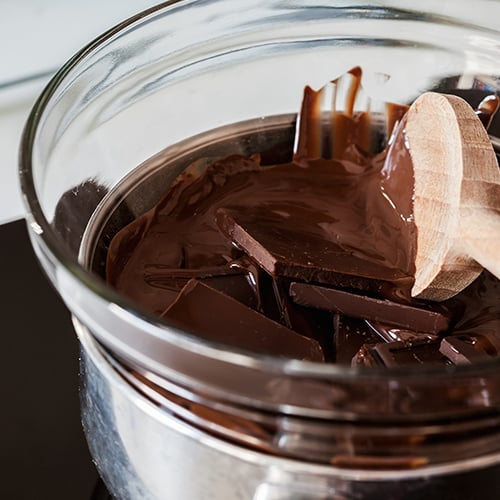
If you are looking to elevate the dessert offerings served out of your commercial kitchen, mastering the art of tempering chocolate is a must. By carefully controlling the temperature of melted chocolate, you can achieve a shiny finish, that classic snap, and a longer shelf life for your chocolate creations. Whether you're dipping strawberries, making truffles, or coating pastries, understanding the basics of chocolate tempering will take your confectionery skills to the next level.
What Is Tempering Chocolate?
Tempering chocolate is the process of heating and cooling chocolate to specific temperatures in order to stabilize the cocoa butter crystals within the chocolate. This ensures that the chocolate has a glossy appearance, a smooth texture, and a satisfying snap when broken.
Why Temper Chocolate?
Properly tempered chocolate is essential for creating a variety of confections such as truffles, bonbons, chocolate bars, and decorations for desserts. When chocolate is melted, the cocoa butter crystals become unstable and can form into different crystal structures. If the chocolate is not tempered correctly, it can result in a dull appearance, a gritty texture, and a soft consistency that easily melts at room temperature. Tempering is a key step if you are planning to ship chocolate and have it arrive to your customer looking shiny and presentable.
Best Way to Temper Chocolate
There are a few ways that you can temper your chocolate for that perfect glossy sheen. The most common chocolate tempering methods are seeding and tabling. For these methods, you’ll want to begin the process by properly melting your chocolate using a double boiler. A chocolate tempering machine is also a convenient way to melt and temper chocolate at the press of a button. We’ll walk you through these tempering methods to help you prepare eye-catching chocolate creations to impress your guests.
Seeding Chocolate

Seeding chocolate is a technique used in tempering chocolate that involves adding small pieces of unmelted chocolate to melted chocolate to help it cool to the desired temperature. This helps to introduce stable cocoa butter crystals into the melted chocolate and create that smooth texture in the final product. To learn how to temper chocolate by seeding, follow the instructions below:
- Melt the Chocolate: Begin by melting 2/3 of your chocolate using a double boiler. Make sure to stir the chocolate frequently to ensure even melting. Be careful not to introduce any water into the chocolate or it will seize.
- Monitor the Temperature: Using a candy thermometer, check the chocolate’s temperature until it reaches the appropriate melting point for that chocolate type. Most chocolates melt between 104 and 113 degrees Fahrenheit.
- Seed the Chocolate: Once the chocolate is completely melted, remove it from the heat source and add small pieces of the remaining unmelted chocolate to the melted chocolate. This will begin to drop the temperature gradually and can take several minutes depending on your batch size.
- Stir and Cool: Stir the chocolate continuously as the seed chocolate melts into the melted chocolate. Monitor the temperature with a candy thermometer until the chocolate cools to about 82 degrees Fahrenheit.
- Reheat the Chocolate: Once the chocolate reaches 82 degrees Fahrenheit, return the bowl to the double boiler and stir as the chocolate temperature rises between 86 and 90 degrees Fahrenheit for dark chocolate or 87 degrees Fahrenheit for milk and white chocolate.
- Test the Chocolate: With a spoon, streak some of the tempered chocolate on a piece of wax paper to confirm that you have achieved a glossy sheen. If it appears dull or streaky, the chocolate crystals did not properly stabilize and would need to undergo the tempering process again.
- Work with Your Chocolate: Your chocolate is now tempered and ready to use for dipping, molding, or any other applications. Remember to work quickly and efficiently as tempered chocolate sets relatively quickly.
If your chocolate begins to thicken or cool during use, you can gently reheat it in short bursts in the microwave or over a double boiler. Be cautious not to overheat the chocolate, as this can cause it to lose its temper.
Tabling Chocolate

Another popular method for tempering chocolate is tabling, which involves manipulating the temperature of the chocolate through a series of controlled movements on a cool surface. Here’s how you can table chocolate effectively:
- Melt the Chocolate: Melt your chocolate in a double boiler, making sure not to exceed the recommended temperature for the type of chocolate you are using (between 104 and 113 degrees Fahrenheit).
- Table the Chocolate: Once melted, pour 2/3 of the melted chocolate onto a clean, cool marble cutting board or granite surface. Use a spatula to spread and agitate the chocolate, moving it back and forth across the surface. Make sure the surface is completely dry before spreading.
- Spread and Thicken: Continue spreading and gathering the chocolate with a bench scraper or palette knife until it starts to thicken and form peaks as it drips off the scraper. This process helps to evenly distribute the temperature throughout the chocolate, encouraging the formation of stable cocoa butter crystals.
- Incorporate the Chocolate: Once the chocolate has reached between 78 and 82 degrees Fahrenheit, scrape it back into the remaining 1/3 of the melted chocolate. Stir gently to combine the two portions, ensuring that the tempered chocolate is smooth and homogeneous. The melted chocolate will gradually raise the temperature of the table chocolate to workable temperatures (86 and 90 degrees Fahrenheit for dark chocolate, 87 degrees Fahrenheit for milk and white chocolate).
- Test the Chocolate: To test if your chocolate is properly tempered, dip a small piece of parchment paper or knife blade into the chocolate and allow it to set. The chocolate should harden within a few minutes, forming a shiny, smooth surface.
Chocolate Tempering Machine

A chocolate tempering machine is designed to precisely control the temperature of melted chocolate, ensuring that it sets properly with a glossy finish and a satisfying snap. By following these steps and utilizing a chocolate tempering machine, you can achieve perfectly tempered chocolate for all your commercial baking with minimal effort:
- Prepare the Chocolate: Before using a chocolate tempering machine, ensure that your chocolate is chopped into small, uniform pieces. This will help the machine melt the chocolate evenly and efficiently.
- Set Up the Machine: Place the chocolate tempering machine on a level surface near a power outlet. Make sure the bowl and any other components are clean and dry before starting the tempering process.
- Melt the Chocolate: Add 2/3 of the chopped chocolate to the machine's bowl and set the temperature according to the type of chocolate you are using. The machine will gradually melt the chocolate to the desired consistency.
- Seed the Chocolate: Tempering machines will beep when it is time to introduce the remaining 1/3 of the chopped chocolate. By selecting a tempering mode, the machine will drop the temperature to allow the chocolate to cool at the appropriate rate while incorporating the added chocolate to stabilize the cocoa butter crystals.
- Reheat the Chocolate: Once mixed, the machine will increase the temperature gradually to bring the melted chocolate back to a workable temperature. Most chocolate tempering machines will beep when the chocolate is ready for use.
- Test the Chocolate: Check the chocolate for its signature shiny appearance by dipping a piece of parchment paper in the chocolate and allowing it to set. The tempering machine will hold the chocolate at the appropriate temperature so you can work without rush.
Best Chocolate for Tempering

Not all chocolates are created equal, so selecting the best chocolate for tempering is essential for successful results.
- Couverture Chocolate: Couverture chocolate contains a higher percentage of cocoa butter compared to other types of chocolate. This makes it ideal for tempering, as the higher cocoa butter content allows the chocolate to set properly and maintain a glossy appearance. Couverture chocolate is favored by professional chocolatiers for its superior taste and texture.
- Dark Chocolate: Dark chocolate is another excellent choice for tempering. With its rich flavor profile and lower sugar content, dark chocolate is well-suited for a variety of applications, from molding and dipping to enrobing. Dark chocolate typically contains at least 70% cocoa solids, which contributes to its intense flavor and smooth texture when tempered correctly.
- Milk Chocolate: Milk chocolate is a popular choice for tempering due to its creamy and sweet taste. While milk chocolate contains fewer cocoa solids than dark chocolate, it still provides a delicious and smooth finish when tempered effectively. When tempering milk chocolate, it is important to pay attention to the temperature and avoid overheating to prevent the chocolate from seizing.
- White Chocolate: White chocolate, despite not containing cocoa solids, can also be tempered for a smooth and velvety finish. White chocolate is made from cocoa butter, sugar, and milk solids, giving it a rich and creamy flavor. When tempering white chocolate, it is essential to be mindful of the delicate nature of cocoa butter to achieve the desired consistency and shine.
Chocolate Tempering Temperatures
Different types of chocolate require specific temperature ranges to ensure proper tempering. Here are the key temperatures you need to know:
- Dark Chocolate Tempering Temperature: 82 - 84 degrees Fahrenheit
- Milk Chocolate Tempering Temperature: 81 - 82 degrees Fahrenheit
- White Chocolate Tempering Temperature: 79 - 81 degrees Fahrenheit
- Ruby Chocolate Tempering Temperature: 83 - 85 degrees Fahrenheit
Back to Top
By mastering the art of tempering chocolate, you can achieve professional-quality results for your commercial bakery, pastry shop, or chocolatier. Tempered chocolate will not only enhance the appearance of your confections but also improve their texture and flavor, making them a delight for your customers to enjoy. Put your tempering skills to the test by stocking up on our chocolate molds for your confectionary creations.





